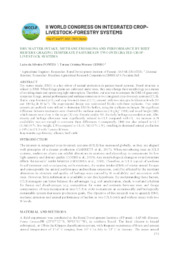Dry matter intake, methane emissions and performance by beef heifers grazing temperate pastures in two integrated croplivestock systems.
Dry matter intake, methane emissions and performance by beef heifers grazing temperate pastures in two integrated croplivestock systems.
Author(s): PONTES, L. da S.; GENRO, T. C. M.
Summary: Dry matter intake (DMI) is a key driver of animal production in pasture-based systems. Sward structure is related to DMI. When forage plants are cultivated under trees, they may change their morphology as a means of avoiding shade and optimizing light interception. Therefore, our aim was to compare the DMI of grass-only temperate forage, animal performance and methane emissions in two integrated crop-livestock systems (ICLS), that is: crop-livestock (CL) and crop-livestock-trees (CLT), crossed with two nitrogen fertilization levels (90 and 180 kg de N ha-1). The experimental design was randomized blocks with three replicates. Two tester animals per paddock were utilized to determine DMI by heifers, using the n-alkanes technique. No significant difference between treatments were observed for methane emissions (34 g kg-1 DMI) and sward height (SH), which means were close to the target (20 cm). Despite similar SH, the daily herbage accumulation rate, tiller density and herbage allowance were significantly reduced in CLT compared with CL. An increase in N availability was not enough to overcome these differences. Consequently, DMI was also reduced in CLT (1.5±0.04 % live weight, LW) compared to CL (1.7±0.05 % LW), resulting in decreased animal production (-38%) in ICLS with 7-years old trees.
Publication year: 2021
Types of publication: Paper in annals and proceedings
Keywords: Gado de Corte, Metano, Pastagem
Observation
Some of Embrapa's publications are published as ePub files. To read them, use or download one of the following free software options to your computer or mobile device. Android: Google Play Books; IOS: iBooks; Windows and Linux: Calibre.
Access other publications
Access the Agricultural Research Database (BDPA) to consult Embrapa's full library collection and records.
Visit Embrapa Bookstore to purchase books and other publications sold by Embrapa.

